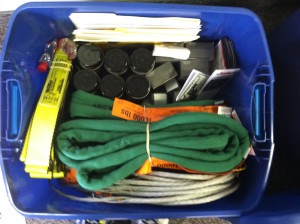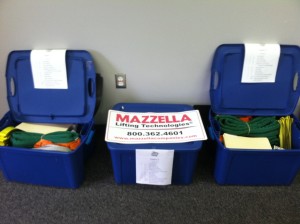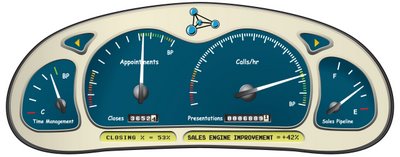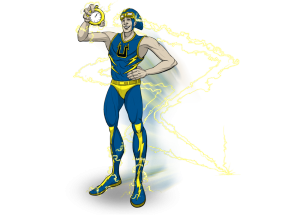Just Make A Movie…
Few people realize the opportunity they have right in front of them. They think some bolt from the blue is going to hit them and change their fortunes forever.
George Lucas recognized his….
“When I was in film school, the big issue was
‘When are we going to get to make a movie?’ …
They gave us 32 feet of 16 mm film which was exactly 1 minute of film … I turned it into a 1-minute movie.
If somebody gave me 100 feet of film … I made a movie out of it. And the other kids basically didn’t. They had the same 100 feet of film. They had the same camera. And, they just said ‘When am I going to get to make a movie?’ And I just kept making them.”
George Lucas
…and the result was
and
What are you going to do with your opportunity today?
What you need in the field for a successful Sales Blitz!
In a Sales Blitz every door is an opportunity and if your salespeople aren’t properly equipped they can miss it.
Sales….. Like Lightning
“How can we achieve a near-term sales increase combined with long-term sustainable revenue growth?”
This is a question that hangs in the air during virtually every conversation between owners, C-Level and Sales Management. One of the tried and true methods to achieve at least half of the equation is to conduct a sales blitz. The trick is how do you morph a temporary sales boost into the “new normal”?
A sales blitz is designed to fulfill the urgent need of increasing sales pipelines immediately. And most sales organizations know the basic “flavors” of blitzes with formats being designed for, at best, impermanent returns. I say both goals of an immediate sales bump and establishing the “new normal” are possible.
It’s a challenge melding lead generation, continual development training and motivational sales meetings, I grant you, but if you run a Blitz using this system be prepared for a revenue growing, “sales climate changing” event.
 S.E.T.U.P. your team for success
S.E.T.U.P. your team for success
Strategy
This step should start minimally 60 days before the blitz. Map out EVERY detail from the initial touch, phone dial, live visit, all follow-up and ongoing relationship builders and more. At the planning meeting ask these questions:
-
What market/area are you attempt to penetrate?
-
What is the goal(s) of the blitz? Short term, Mid Term and Long Term?
-
How can you warm up the market/area you will be blitzing?
-
What will you use to warm them up? What frequency? What platform?
-
What products fit/are most desired by this market?
-
What vendors should you team with?
-
What should your teams have with them? Brochures? Giveaways?
-
What will be the competition’s reaction?
These questions are a great starting point but you have to go deeper yet. We all know long term sales success is about the grind. Doing the little things everyday that build best practice habits that ultimately pay off. It’s the same here only we need to “microwave” the process a bit.
Education
Day 60 should begin with teaching of an effective lead generation system and every system is made up of 3 things, tactics, strategy and learned skills.
Many of the tactics and strategies that need to be adopted are here https://matriximpact.com/site/?p=1125.
Your team also need SPECIFIC skills. Those skills need to be practiced in real-life simulations tightly tied to the reality they will experience. Here are 5 of the skills that will be required of anyone participating in the Blitz.
-
Client research and its application
-
Tele-Sales: Warming up the drop-in
-
Lobby Intro: Getting past the Gate Keeper or at least gaining needed info
-
Benefit Value Discussion: Setting the hook to continue the discussion
-
Facility Walk-through Technique: How do you maximize contact with the right person?
-
Wrapping up the visit: Very few drop-ins will result in a sale. The real goal is increase and expand in your sales pipeline
There should be a regular schedule of training leading up to the Blitz event. Refresher classes, reviews and Blitz day reminders for everybody involved. This is why there needs to be a Blitz QB. One who can coordinate information, learning and distribution for all the Blitz teams.
Tools
There are many tools needed for a successful Blitz. Call Template, all lead generation letters, impact touches, pairing maps, company intelligence, handouts, giveaways schedules and more, all customized for your business and for the goal of your Blitz.
The key is to be prepared and start the assembling of your tools sooner rather than later.
Users & Interface
Everything management does HAS TO BE hands-on. Management needs to be the great guiding hand in the structure of the Blitz but it also needs to be a participant during the Blitz days. I have had everyone from Middle Managers to Vice President’s of Sales to Owners come up to me after a Blitz and effusively say “John, thank you for making sure I was on a Blitz team”.
Think about it. They get out of the office routine of meetings and problems and get to spend minimum 2 days with sales people and customers. They find out what the ground troops do on an everyday basis and what has changed over the years. They hear first hand customer’s issues and concerns. It can reinvigorate the most curmudgeonly of management and this isn’t even the best reason.
When a prospect/customer is introduced to the Vice President or Owner the look on their face is priceless. I mean WOW, the VP or Owner took time out of her/his day to come and visit. Few gestures have a greater customer service impact than this.
Sales people MUST take ownership as well. They have to be involved in all strategy discussions. There a a multitude of tasks that need to be divvied up among the sales team. A sales person has to be the in-office Blitz QB. This is a critical position. Their job is to coordinate all activity. They have to stay in touch with the teams and provide updates. They are also troubleshooters as opportunities or problems come up. Depending on the size of the blitz you can have as many 2 or 3 QB’s to ensure you have proper support.
The bottom-line: from ownership to front-line sales, everybody plays a crucial role in the execution of a successful Blitz .
Performance
This is what it is all about! You need to GUARANTEE your team is prepared, practiced and energized. If you do you will be SETUP! to have a successful Blitz day(s) and to continue your success throughout the year.
After your strategy meeting(s) you need to conduct
-
Weekly update meetings: No longer than 30 minutes but it is CRITICAL to make sure everyone is completing their assigned duties, remember there is no small job when executing a Blitz.
-
Minimum of 3 education sessions: Would you rather your salespeople practice on their customers or with you?
-
Blitz Kickoff: Night before the Blitz you cover every detail and logistic necessary and take all questions. Team & territory assignments, Car stock, Vendor presentation and motivation. Make sure you have daily goals and prizes for performance as well.
-
Blitz Day: Everybody rallies at central location, unless territory demands call in. You go over any final pieces and send them off to kick BUTT.
-
Blitz Day Re-Cap: Everybody reconvenes at central location. You cover the results, hand out daily prizes, share successes, what worked and what didn’t then break for dinner.
-
Blitz Wrap Up: Similar to Re-Cap. You also need to triage all leads and assign to proper parties. Agree on timing of followup meetings to check progress of leads, generally think 2 weeks out, a month out and 90 days out. This will allow you to see “the toothpaste getting squeezed through the tube”.
Below are the Performance results from a tightly run, well executed Blitz.
You need to lay the ground work for continued nurture prospecting that leads to a steady stream of sales revenue for the foreseeable future. This process focuses on installing habits in your sales team and helping to either create or augment a lead generation system. When executed correctly, a Blitz will bring in immediate sales dollars and set the tone for ongoing success within your current selling environment.
A Blitz is not a band-aid type solution to improving sluggish sales. It’s an organic, holistic method to improving today’s sales revenue AND your overall sales atmosphere, establishing a “new normal” to your team’s everyday sales activities and results.
5 ½ Reasons Why You Should Include Simulations in Your Hiring and Training Processes
People are your most precious resource. Nobody WANTS to make a mistake in hiring or promotions. When it comes to training Andy Grove, the Intel visionary, said it best, “The most important charge a good manager owns is the responsibility to continuously train his/her employees.”
Below are the 5 ½ reasons why simulations should be an integral part of your hiring, promotion and training processes.
-
The 5 to 1 Ratio
A mis-hire/promote costs the company 5 times the candidate’s annual compensation ($50,000 salary costs the company $250,000).
With training its just as easy to see the ROI. A business parable for you:
CEO said to the CFO ‘We have to train our people to get better.’
CFO says ‘Yea but what if we invest time and money to train them and they leave us to go to our competitor?’
CEO shoots back ‘What if we don’t train them and they stay?’
Whether it is a mis-hire or a less than adequately trained employee the impact on client relations, revenue, productivity, supervision time and morale is negative and it is huge.
-
The Power of Proof
Have you ever had an interview where the person told you they couldn’t do the job? Or have you ever had a person who “stretched” their abilities in the interview and as a result you were cleaning their messes for days, weeks or months after?
A best practice simulation provides you “Point-to-Point Correspondence” with the job. When the activities found in the simulation are a replica of activities that are required on the job, you get an accurate portrayal of skill level.
This is also why simulations are critical to training. Do you really want salespeople “practicing” on customers? Of course you don’t! General George Patton once said “The more my troops sweat in peacetime the less they bleed during combat.” Simulations are a must in all continual development.
-
How do They Handle the Debrief
Once they perform in the simulation how do they respond to constructive criticism? Are they thin-skinned? Do they gloat? Is their self-confidence warranted? Many times, you find out the best and the worst of people by observing how they handle coaching.
It also opens a window to know how they learn best. Through the Debrief you will discover what they will and won’t respond to. This can be invaluable as you continue to train and develop your team.
-
Go to the Video
When recorded, simulations help reduce, if not remove bias and subjectivity in the hiring process in one BIG way, “The eye in the sky does not lie.” You don’t want a he said/she said situation in any business scenario, but especially in simulations.
Here’s a great example of the benefit of recording simulations: A hiring manager who got a ‘good hit’ off a candidate, in an interview, might get a completely different feeling after watching a recorded simulation. The candidate might be the most charming person in the world, but when the time came he didn’t have the skills he trumpeted. In any business, that is a disaster averted.
Recorded simulations are irreplaceable in training as well. There is nothing better than being able to go back and review specific areas for either praise or correction. Plus, reviewing with individuals their recorded progress or regression is a very powerful training tool.
-
Onboarding
Even if somebody is an A-Player it does not mean they are perfect. Too many onboarding programs fail to adapt to the candidate, thus slowing the speed to effectiveness of the new hire.
Simulations don’t just weed out bad candidates. They also help you to assess a good candidate’s specific strengths and weaknesses in a hyper-accurate way. This allows you to design/implement an onboarding process to speed them to productivity. Not to mention it helps in offer decisions like salary negotiations.
5 ½. Positioning Your Company as the Best
The War for Talent is upon us and there are only so many A-Players out there. The mistake most organizations commit is purposefully making the hiring process easier out of fear of losing the candidate.
Thomas Payne said, “What we obtain too cheap, we esteem too lightly: it is dearness only that gives everything its value.” Being with the BEST requires paying the PRICE. Candidates learn respect for the position and respect for the company by demonstrating how seriously the company takes the hiring process. The best  candidates don’t want to be with some company that just rolls over. Remember everybody wants to belong to The Club that is impossible to get in.
candidates don’t want to be with some company that just rolls over. Remember everybody wants to belong to The Club that is impossible to get in.
87% of people who voluntarily (i.e .Quit) leave a company do so because of a lack of growth and development opportunity. Its human nature to want to improve, to develop new skills, succeed and advance. If you have good people, make them better.
Use simulations to continually train and develop your team. And you know what they call the company with the top employees… they call that company the BEST!
To ensure you are hiring A-Players and for training to be impactful and ‘sticky’ both have to be closely tied to how things are actually done in your organization. This is why simulations are such a critical management tool.
What are the Metrics that Matter?
Most Sales Departments stink when it comes to tracking their numbers. The question upper management ALWAYS asks is why? My two cents; we don’t know the most important numbers to track and we don’t realize how important they are to our entire selling effort. Well, those excuses end today!
Indicators
The first area that we need to clear up is the difference between trailing and leading indicators. Trailing indicators refer to metrics that happen as a RESULT or in the past. Number of sales closed or total dollar amount closed are examples of the trailing variety. Leading indicators are what foretell objectives and what results will be in the future. The activities that a sales person performs on a daily basis, such as phone calls or appointments, are examples of leading indicators.
We always need to know how many and how much business has been closed (trailing) but we can’t control the actual closing of the sale. That is why we can never lose sight of the activities (leading) it takes to fill the pipeline and, more importantly, directly affect the closing of the sale. This is crucial to short and long term forecasting accuracy and critically more important to overall SALES SUCCESS.
Leading Metric Indicators
I first focus on the BIG 4 of Leading Metric Indicators (LMI’s): Calls, Discovery Appointments, Presentations and Closes. These are pillars of a sale that will tell you the overall picture of what is working, why it is working and what needs to be fixed.
The next LMI’s that I track are more descriptive of the sales reps everyday work.
- How many leads (non-qualified contacts) are they working on?
- How many opportunities (qualified contacts in the buying cycle) are they working on?
- What type of accounts are the reps calling on?
- What is the job function of their main contact?
If the BIG 4 gives you the overall picture, when you drill down to this level you uncover more of the texture in the everyday activities of your sales team. Not just the raw numbers but WHY you are getting the raw numbers. When we understand both sets of LMI’s and their conversion rates it helps us to more accurately predict closing rates in the near and long term.
Trailing Metrics Indicators
I always track total number of closed sales and total sales dollars. They are important and necessary to measure where we have finished historically, yet it always amazes me what sales management forgets to measure in the Trailing Metric Indicator (TMI) category.
A.U.S.P. or average unit selling price is the total sales dollars divided by the total number of sales. For example if total sales dollars are $100,000 and total number sales are 10 your A.U.S.P. equals $10,000. Knowing this number tells you how many sales it will take to hit your objective. This TMI is key to planning your goals and objectives throughout the year.
The final TMI I track is Average Velocity of Sale or the A.V.O.S. This is the average time from when a lead becomes an opportunity to when it converts to a sale. Having the handle on this metric allows you to realistically plan WHEN your business is going to hit.
Wrap Up
12 chapters of data making up one book; lose one of the chapters and you wonder how and why things are happening. Lose two chapters and the story starts to sound nonsensical. Lose three and you wonder why you started reading the book at all. 12 categories of data when monitored and measured can radically affect your sales team’s short and long term success and viability.
Sure it takes time and getting sales to record their info is difficult. Keeping up with the numbers is a job in of itself. I have heard all of the excuses before. I leave you with a question. If you could produce a set of numbers telling you how to improve, what to improve and when to improve your sales results wouldn’t you want to know them and wouldn’t you do everything in your power to track them? Yea, I don’t know either…
Be Hassle Free
I was clicking through the cable stations the other night and settled on a rerun of “The West Wing” for some background noise. Not particularly paying attention until toward the end of the episode I heard a line from the character of ‘Danny Cocannon’ talking to ‘Charlie Young’.
Charlie was lamenting dating the President’s daughter because of various issues, I couldn’t tell you what (again background noise). Then I heard Danny say “If it was me I would want to be the one hassle free person in her life” BOOM. Isn’t that EXACTLY what we should be to our customers?
(You Can View the clip here Be The 1 hassle free Person)
We should be the one hassle free thing in our customers’ life. As salespeople we spend most of our time strategizing on how to find the customer, how to question the customer and how to negotiate with the customer so we can win the sale. What if INSTEAD we spent a little more time thinking about things from their perspective?
Our customers, by definition, have to be decision makers. As a general rule, they must have some level of authority and responsibility. So what daily tasks, problems and ordeals accompany those two duties?
- 100’s of phone calls
- 100’s of email
- Management reporting and meetings
- Employee problems
- Internal power struggles
- Logistical challenges
- Other vendors issues
- Personal issues
I know what you might be thinking. “My boss doesn’t care about these things” or maybe “I have quota to make I can’t worry about their problems.” Well I am here to tell you if you don’t worry about their problems you will NEVER solve your own!
There are 1000’s of things that can crop up at any time for our customer and we are only ONE of them. The patience and professionalism we exhibit in working our way into customer’s daily schedule will determine how they perceive us and ultimately the level of success we experience.
Below are 5 ways we can Be Hassle Free in the face of these daily dilemmas:
- Only call if you have a REASON or NEED to call, not because “I just wanted to…”
- Email if you have something relevant, helpful, informational etc. not the joke of the day or “I was just checking in.”
- Respect their time! Recognize you are only one small part of their day and make the time you share with them COUNT. Be prepared for every meeting, phone call and presentation. Never waste their time.
- If they choose to share any problem situation with you tread carefully. YouARENOT the business equivalent of Dr. Ruth, but you can find information online that might address their concerns.
- Be humble and empathize but DO NOT commiserate. Realize there will be problems you can’t help with but let them know you understand their situation and will be as supportive as possible.
It comes down to this; we need to find a way to become a POSITIVE in the customer’s day. Whenever they see your number on caller ID they should want to take the call because they know you will share something of value with them. You might be calling with an idea or with information about their industry or maybe even a solution to their problem. Whatever it may be, they have to WANT to talk to you.
Be the one hassle free thing in their daily existence; an oasis from the desert of problems they face. Provide valuable resources and make their life easier. Find something they need that has NOTHING to do with your business and HELP THEM. You have to go OUTSIDE your job description and do things your competitors wouldn’t even think of if you truly want to help people.
It is a lot of work I know but I promise, if you do, the business relationship will grow and your sales will skyrocket. It is a choice you have to make everyday so choose wisely, the job you save just might be your own.
You Might be a Commodity if….
Most of us remember Jeff Foxworthy’s famous routine “You might be a redneck if…”
- You think “loading the dishwasher” means getting your wife drunk.
- You ever cut your grass and found a car.
- You own a home that is mobile and 5 cars that aren’t.
Just a sample of his more memorable lines to jog your memory (and because I couldn’t resist).
Well, in sales, we have an affliction that is far less funny and much more tragic. When our customers think of us as a commodity they either can’t or don’t perceive the difference between us and our competition and/or they have ZERO recognition of the value of our product/service. I don’t know if there is a more deadly one two punch in sales.
So, in the spirit of Jeff Foxworthy here is a list of some of the most common and DANGEROUS signs of this affliction.
You might be a commodity if…
- After a lead generation campaign, when calling prospects, they don’t recognize your name or your company or worse when they hear your name you hear “UGH, oh Hi John…”
- If you try to set an appointment with a prospect and she says, “Tell you what call me back in a week and I’ll let you know what I want to do then.”
- After the initial discovery appointment the customer tells you thanks for your time and he’ll be in touch.
- During the presentation you ask your prospect what he likes best and he says “Good question” yet never answers you.
- You find yourself negotiating your price on 2 out of every 3 closing presentations.
- Before the presentation they told you they needed to make a decision by next week and now it is next month and you still have not been able to get them on the phone.
- After the presentation you attempt to schedule a next step meeting and your prospect says, “I think we have all the information we need.”
- Calling to schedule a next step meeting your prospect says “what was this about again?”
- You go to a networking function of 100+ people and you don’t come back with ANY actionable leads.
- The closest you get to an opportunity at a trade show is somebody who comes to your booth for the free candy and chotchkies.
We have a webinar coming up on Wednesday December 21st that will offer some cures to this deadly disease and in the meantime, check you and your team for these symptoms. If any of these have manifested themselves my prescription is to attend our webinar and call me in the morning.
Relationships, Slips and Dips
I was at a customer’s last week starting to dig into the Strategy Module for a S.I.T. Blitz we will be conducting the 2nd week in September. Working with the salespeople, we always go through a series of questions to understand their perception of the suspect/prospect/customer (SPC) dynamic which is so crucial when planning for a successful S.I.T. Blitz.
One of the key factors is knowing their standard for SPC communication in terms of frequency. During the course of questions one salesperson chimed in and said “I keep in touch with my suspects and prospects 2x a year, any more than that and I think it would appear pushy.”
Well after the black cloud and threat of lighting inside the building passed I asked him how often does he talk to his best friend? He said probably 2 times a week. Then I asked how often did he call his wife when they were dating? He said minimum 4 times a week. Then I asked him if he considered his relationships with his contacts as solid and he said yes, emphatically, I might add.
So I think you know where I was going with this line of questioning. My final question to him was how many times has he called one of his contacts only to find out that his contact person wasn’t there or there had been a drastic change in the company. His answer “John, more times than I can count,” and therein lies the ‘problemo’ my sales friend.
Believe it or not this happens to me about once a month; a salesperson who understands staying in touch with friends or girlfriends, but doesn’t have a clue what it takes to maintain a successful business relationship. Strangely enough, these same sales people will argue, ‘till blue in the face, they have a good feel for their customers.
I call the first level of this problem Relation-Slip behavior. The sales person “thinks” they know how to stay in touch with a contact. The problem is what they “thinks” has nothing to do with the facts, needs and wants of the suspect/prospect/customer so what winds up happening is a deepening chasm develops between sales and contact with sales being quite oblivious to it. There is a ALWAYS correlation with a drop in sales but the sales person is stuck scratching their head and wondering why this is happening to him.
The next level DOWN is Relation-Dip behavior. The sales person here doesn’t have a clue how to stay in touch with their contacts. They will never admit they have a problem, so they go the other direction and MINIMIZE contact to the point of neglect. You see, in their mind, by not “bugging them” they are maintaining a good relationship. These sales people are so afraid of experiencing the UGH Factor that they will stay away from the suspect/prospect/customer. My question is “If you stay away for long periods of time how will you know when they have become a ripe prospect?” Insert collective silence or righteous indignation ‘here. Then you add the precipitous drop in sales and you have yourself a major issue.
Like any problem in sales early recognition is key. If you are a sales manager WAKEUP! You should be tracking not just their sales production but their lead generation activities. Either one should give you enough of an alert to intervene before the behavior jeopardizes their career and your quota attainment.
If you are a sales person WAKEUP! Your sales are down! Either you don’t spend enough time staying in touch with your customers or you are doing the absolute WRONG things. You have to be self aware enough to say “I have to change what I am doing or this sucker is going down!”
All righty then…. that’s it for today! Next post I will be talking about the solution to Relation-Slips and Dips and the changing nature of the sales contact process.
Until then remember “You can either make sales or you can make excuses but you can’t do both…” I’m outta here!
If you want more information about the S.I.T. Blitz and how you can have a “revenue raining, climate change” experience at your please call Matrix at 216 347 6729 or go to buildyoursalesmachine.com for more details!
Choking HAPPENS
Why do athletic teams practice?
Why do even the most advanced athletes practice the basics over and over?
Why do they review game flims/videos before, during and after an athletic contest?
The answer to the above questions is simple. They do so because they want responses to situations to be essentially automatic. If you can remove the ‘what should I do?’ thought and instead allow the best and brightest to simply react using their God given abilities you have the chance to see real success in athletics. It’s not complicated, you don’t practice and the probability you will ‘choke’ in an unfamiliar situation is VERY HIGH.
It is the same in sales. You have to practice your craft to become the best and also so you can recognize situations and know immediately what the solution to them is. If you can eliminate the ‘I wasn’t expecting that’ commentary, which is another way of saying ‘I choked,’ I promise you will see sales increase.
Now I know some sales people will say ‘I get enough practice in front of my customers’. But think about it for a moment, is that where you really want to practice? What happens if what you try doesn’t work? Whoops, you just lost the sale; and that is the minimum that could go wrong.
The repetition of successful performance results in the “Video Game Effect.” We all know the basic concept of video games. Each level of the game has a ‘boss’ you have to defeat. After learning the needed skills and defeating him you move on to the next level, and so on and so on. Through practice and repetition you improve and have more success in the game. The better you get the more you enjoy the game. The world of sales is no different except that the better we get not only do we enjoy our work more but we make MORE MONEY!
There is science to this as well. When confronted with a scenario you have prepared for, the body will produce a neuro-transmitter called Serotonin. Its main job is to induce a calming effect allowing higher level critical thinking to happen at a much quicker pace. The result is better decisions and actions that dictate performance. Once you start to succeed at the task, the body produces Endorphins which creates the euphoric feeling coming after you have performed at a high level or won a contest. Thus, you become conditioned to want the same feeling over and over which propagates continued performance improvement. You might call it “Addiction to Success.”
Sales managers I strongly urge you to start a regimen of sales simulations with your team. You should have each member of the team submit a situation where they either lost the sale or didn’t move the process forward on a monthly basis. Also, build up your “Catalog” through your experience in the field riding with your team. Turn those actual events into simulations and before you know you will have a docket of potential selling scenarios that you can use to help develop your team and reduce the “Choking Happens Syndrome.”
Last thing; always do a post mortem, an evaluation on both live events and the simulations. Make sure your team knows what they did right, what they could do better and what they better not do EVER again. Eliminate the ‘what if’ from you and your team’s vocabulary and watch the sales numbers soar.
Hiring A Sales Superstar: Constructing & Conducting a Sales Simulation
John C. KolencikWhen I was a kid and would get into trouble almost always my parents would find out. The next 20 minutes, after their discovery, I would spend apologizing, trying to avoid the inevitable punishment that was coming. That’s when my parents came right back everytime and said “John Christopher Kolencik your actions speak louder than your words” emphasis THEIRS!Why do we take a candidate’s word for it when they say that they can sell? Oh, right it says they can on their resume’. Yea, and their references said they can too. Well I have waited a long time to say this instead of hearing it “your actions speak louder than words”.
Sales simulations are a KEY tool in discovering the actual skill level of any potential sales hires. Think about it, what tells you more about a person besides how they actually react in a particular situation? And the beauty of the sales simulation is that you can construct it EXACTLY to the experiences you have everyday.
There are a 1o steps that must be adhered to so the simulation will yield the results and information you need to help in your hiring selection. I will detail 9 of them today and the 10th will be in my next post.
- Give the candidate access to any advice or resources that a currently employed sales person would have but don’t prompt them to specifics. If they ask great but if they don’t, well that tells you something right there doesn’t it?
- Make sure that the simulation is based in your everyday reality. Harder is better than easier but straying to either extreme garners you nothing but wasted time.
- Each step in YOUR actual sales process should be simulated, no short cuts!
- Detail out, internally, how you define success in the simulation. This gives you an un-biased road map to grade/assess the candidate.
- There should be multiple “actors” in any simulation. When was the last time you were involved in a sale that didn’t have multpile parties involved?
- Write defined roles and direction for the “actors”, don’t rely on their “acting chops”. This removes any bias or random mistakes.
- Include “planned interruptions” during the course of the simulation. What sale have you been a part of where your meetings were never interrupted?
- Always include a letter/proposal writing segment in any simulation. What a deflation it is to find your new star sales hire “don’t write too good”.
- Record it, minimum audio but preferably video. See my last post as to why.
- Conduct a Critique Session.
That’s it for today. If you have any questions or need any help constructing/conducting a Sales Simulation give me a call at 216-347-6729. Make sure to check back for my next post where I detail out Number 11; How to conduct an effective Critique Session. And believe you me if you thought the Simulation was an eye-opener just wait to see what you will learn by critiquing your candidate’s performance.
Archives
- May 2018
- November 2016
- June 2016
- April 2016
- March 2016
- February 2016
- January 2016
- February 2012
- January 2012
- December 2011
- October 2011
- August 2011
- July 2011
- June 2011
- May 2011
- April 2011
- March 2011
- February 2011
- July 2009
- June 2009
- May 2009
- August 2008
- June 2008
- May 2008
- April 2008
Categories
- A-Players
- Best Practice
- Change
- Cold Call
- Communication Skills
- Continual Development
- Critique Session
- Customer
- D.I.G.
- Drive
- Firing
- Guts
- Handling criticism
- Hiring and Assessment
- Hiring Dashboard
- Human Resources
- Intelligence
- interview questions
- Interviewing
- interviewing sales superstars
- Lead Generation
- Leads
- Motivation
- Naturally Curious
- New Contact Touches
- Position Contracts
- Proposals That Sell
- Prospects
- Reference Checks
- S.I.T. Blitz
- S.I.T. Nurture Prospecting System
- S.I.T. Touch
- Sales 3.0
- Sales Blitz
- Sales Management
- Sales Superstars
- Simulations
- Skill Sets
- Staffing
- Suspect/Prospect/ Customer Dynamic
- Suspects
- Talent and Traits
- Termination
- Uncategorized














